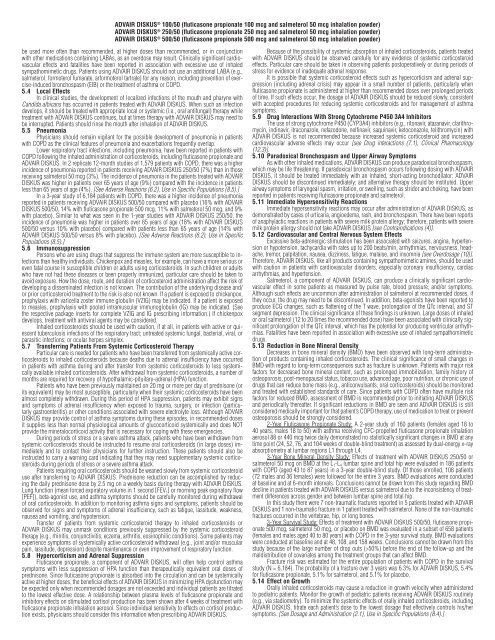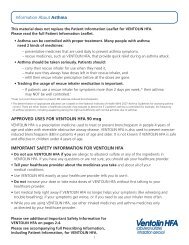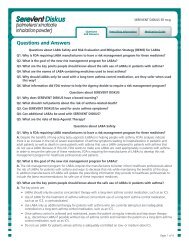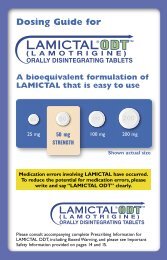FDA Approved Long-Acting Beta Agonists - GSK Source
FDA Approved Long-Acting Beta Agonists - GSK Source
FDA Approved Long-Acting Beta Agonists - GSK Source
You also want an ePaper? Increase the reach of your titles
YUMPU automatically turns print PDFs into web optimized ePapers that Google loves.
ADVAIR DISKUS ® 100/50 (fluticasone propionate 100 mcg and salmeterol 50 mcg inhalation powder)<br />
ADVAIR DISKUS ® 250/50 (fluticasone propionate 250 mcg and salmeterol 50 mcg inhalation powder)<br />
ADVAIR DISKUS ® 500/50 (fluticasone propionate 500 mcg and salmeterol 50 mcg inhalation powder)<br />
be used more often than recommended, at higher doses than recommended, or in conjunction<br />
with other medications containing LABAs, as an overdose may result. Clinically significant cardiovascular<br />
effects and fatalities have been reported in association with excessive use of inhaled<br />
sympathomimetic drugs. Patients using ADVAIR DISKUS should not use an additional LABA (e.g.,<br />
salmeterol, formoterol fumarate, arformoterol tartrate) for any reason, including prevention of exercise-induced<br />
bronchospasm (EIB) or the treatment of asthma or COPD.<br />
5.4 Local Effects<br />
In clinical studies, the development of localized infections of the mouth and pharynx with<br />
Candida albicans has occurred in patients treated with ADVAIR DISKUS. When such an infection<br />
develops, it should be treated with appropriate local or systemic (i.e., oral antifungal) therapy while<br />
treatment with ADVAIR DISKUS continues, but at times therapy with ADVAIR DISKUS may need to<br />
be interrupted. Patients should rinse the mouth after inhalation of ADVAIR DISKUS.<br />
5.5 Pneumonia<br />
Physicians should remain vigilant for the possible development of pneumonia in patients<br />
with COPD as the clinical features of pneumonia and exacerbations frequently overlap.<br />
Lower respiratory tract infections, including pneumonia, have been reported in patients with<br />
COPD following the inhaled administration of corticosteroids, including fluticasone propionate and<br />
ADVAIR DISKUS. In 2 replicate 12-month studies of 1,579 patients with COPD, there was a higher<br />
incidence of pneumonia reported in patients receiving ADVAIR DISKUS 250/50 (7%) than in those<br />
receiving salmeterol 50 mcg (3%). The incidence of pneumonia in the patients treated with ADVAIR<br />
DISKUS was higher in patients over 65 years of age (9%) compared with the incidence in patients<br />
less than 65 years of age (4%). [See Adverse Reactions (6.2), Use in Specific Populations (8.5).]<br />
In a 3-year study of 6,184 patients with COPD, there was a higher incidence of pneumonia<br />
reported in patients receiving ADVAIR DISKUS 500/50 compared with placebo (16% with ADVAIR<br />
DISKUS 500/50, 14% with fluticasone propionate 500 mcg, 11% with salmeterol 50 mcg, and 9%<br />
with placebo). Similar to what was seen in the 1-year studies with ADVAIR DISKUS 250/50, the<br />
incidence of pneumonia was higher in patients over 65 years of age (18% with ADVAIR DISKUS<br />
500/50 versus 10% with placebo) compared with patients less than 65 years of age (14% with<br />
ADVAIR DISKUS 500/50 versus 8% with placebo). [See Adverse Reactions (6.2), Use in Specific<br />
Populations (8.5).]<br />
5.6 Immunosuppression<br />
Persons who are using drugs that suppress the immune system are more susceptible to infections<br />
than healthy individuals. Chickenpox and measles, for example, can have a more serious or<br />
even fatal course in susceptible children or adults using corticosteroids. In such children or adults<br />
who have not had these diseases or been properly immunized, particular care should be taken to<br />
avoid exposure. How the dose, route, and duration of corticosteroid administration affect the risk of<br />
developing a disseminated infection is not known. The contribution of the underlying disease and/<br />
or prior corticosteroid treatment to the risk is also not known. If a patient is exposed to chickenpox,<br />
prophylaxis with varicella zoster immune globulin (VZIG) may be indicated. If a patient is exposed<br />
to measles, prophylaxis with pooled intramuscular immunoglobulin (IG) may be indicated. (See<br />
the respective package inserts for complete VZIG and IG prescribing information.) If chickenpox<br />
develops, treatment with antiviral agents may be considered.<br />
Inhaled corticosteroids should be used with caution, if at all, in patients with active or quiescent<br />
tuberculosis infections of the respiratory tract; untreated systemic fungal, bacterial, viral, or<br />
parasitic infections; or ocular herpes simplex.<br />
5.7 Transferring Patients From Systemic Corticosteroid Therapy<br />
Particular care is needed for patients who have been transferred from systemically active corticosteroids<br />
to inhaled corticosteroids because deaths due to adrenal insufficiency have occurred<br />
in patients with asthma during and after transfer from systemic corticosteroids to less systemically<br />
available inhaled corticosteroids. After withdrawal from systemic corticosteroids, a number of<br />
months are required for recovery of hypothalamic-pituitary-adrenal (HPA) function.<br />
Patients who have been previously maintained on 20 mg or more per day of prednisone (or<br />
its equivalent) may be most susceptible, particularly when their systemic corticosteroids have been<br />
almost completely withdrawn. During this period of HPA suppression, patients may exhibit signs<br />
and symptoms of adrenal insufficiency when exposed to trauma, surgery, or infection (particularly<br />
gastroenteritis) or other conditions associated with severe electrolyte loss. Although ADVAIR<br />
DISKUS may provide control of asthma symptoms during these episodes, in recommended doses<br />
it supplies less than normal physiological amounts of glucocorticoid systemically and does NOT<br />
provide the mineralocorticoid activity that is necessary for coping with these emergencies.<br />
During periods of stress or a severe asthma attack, patients who have been withdrawn from<br />
systemic corticosteroids should be instructed to resume oral corticosteroids (in large doses) immediately<br />
and to contact their physicians for further instruction. These patients should also be<br />
instructed to carry a warning card indicating that they may need supplementary systemic corticosteroids<br />
during periods of stress or a severe asthma attack.<br />
Patients requiring oral corticosteroids should be weaned slowly from systemic corticosteroid<br />
use after transferring to ADVAIR DISKUS. Prednisone reduction can be accomplished by reducing<br />
the daily prednisone dose by 2.5 mg on a weekly basis during therapy with ADVAIR DISKUS.<br />
Lung function (mean forced expiratory volume in 1 second [FEV1] or morning peak expiratory flow<br />
[PEF]), beta-agonist use, and asthma symptoms should be carefully monitored during withdrawal<br />
of oral corticosteroids. In addition to monitoring asthma signs and symptoms, patients should be<br />
observed for signs and symptoms of adrenal insufficiency, such as fatigue, lassitude, weakness,<br />
nausea and vomiting, and hypotension.<br />
Transfer of patients from systemic corticosteroid therapy to inhaled corticosteroids or<br />
ADVAIR DISKUS may unmask conditions previously suppressed by the systemic corticosteroid<br />
therapy (e.g., rhinitis, conjunctivitis, eczema, arthritis, eosinophilic conditions). Some patients may<br />
experience symptoms of systemically active corticosteroid withdrawal (e.g., joint and/or muscular<br />
pain, lassitude, depression) despite maintenance or even improvement of respiratory function.<br />
5.8 Hypercorticism and Adrenal Suppression<br />
Fluticasone propionate, a component of ADVAIR DISKUS, will often help control asthma<br />
symptoms with less suppression of HPA function than therapeutically equivalent oral doses of<br />
prednisone. Since fluticasone propionate is absorbed into the circulation and can be systemically<br />
active at higher doses, the beneficial effects of ADVAIR DISKUS in minimizing HPA dysfunction may<br />
be expected only when recommended dosages are not exceeded and individual patients are titrated<br />
to the lowest effective dose. A relationship between plasma levels of fluticasone propionate and<br />
inhibitory effects on stimulated cortisol production has been shown after 4 weeks of treatment with<br />
fluticasone propionate inhalation aerosol. Since individual sensitivity to effects on cortisol production<br />
exists, physicians should consider this information when prescribing ADVAIR DISKUS.<br />
Because of the possibility of systemic absorption of inhaled corticosteroids, patients treated<br />
with ADVAIR DISKUS should be observed carefully for any evidence of systemic corticosteroid<br />
effects. Particular care should be taken in observing patients postoperatively or during periods of<br />
stress for evidence of inadequate adrenal response.<br />
It is possible that systemic corticosteroid effects such as hypercorticism and adrenal suppression<br />
(including adrenal crisis) may appear in a small number of patients, particularly when<br />
fluticasone propionate is administered at higher than recommended doses over prolonged periods<br />
of time. If such effects occur, the dosage of ADVAIR DISKUS should be reduced slowly, consistent<br />
with accepted procedures for reducing systemic corticosteroids and for management of asthma<br />
symptoms.<br />
5.9 Drug Interactions With Strong Cytochrome P450 3A4 Inhibitors<br />
The use of strong cytochrome P450 (CYP3A4) inhibitors (e.g., ritonavir, atazanavir, clarithromycin,<br />
indinavir, itraconazole, nefazodone, nelfinavir, saquinavir, ketoconazole, telithromycin) with<br />
ADVAIR DISKUS is not recommended because increased systemic corticosteroid and increased<br />
cardiovascular adverse effects may occur [see Drug interactions (7.1), Clinical Pharmacology<br />
(12.3)].<br />
5.10 Paradoxical Bronchospasm and Upper Airway Symptoms<br />
As with other inhaled medications, ADVAIR DISKUS can produce paradoxical broncho spasm,<br />
which may be life threatening. If paradoxical bronchospasm occurs following dosing with ADVAIR<br />
DISKUS, it should be treated immediately with an inhaled, short-acting bronchodilator; ADVAIR<br />
DISKUS should be discontinued immediately; and alternative therapy should be instituted. Upper<br />
airway symptoms of laryngeal spasm, irritation, or swelling, such as stridor and choking, have been<br />
reported in patients receiving fluticasone propionate and salmeterol.<br />
5.11 Immediate Hypersensitivity Reactions<br />
Immediate hypersensitivity reactions may occur after administration of ADVAIR DISKUS, as<br />
demonstrated by cases of urticaria, angioedema, rash, and bronchospasm. There have been reports<br />
of anaphylactic reactions in patients with severe milk protein allergy; therefore, patients with severe<br />
milk protein allergy should not take ADVAIR DISKUS [see Contraindications (4)].<br />
5.12 Cardiovascular and Central Nervous System Effects<br />
Excessive beta-adrenergic stimulation has been associated with seizures, angina, hypertension<br />
or hypotension, tachycardia with rates up to 200 beats/min, arrhythmias, nervousness, headache,<br />
tremor, palpitation, nausea, dizziness, fatigue, malaise, and insomnia [see Overdosage (10)].<br />
Therefore, ADVAIR DISKUS, like all products containing sympathomimetic amines, should be used<br />
with caution in patients with cardiovascular disorders, especially coronary insufficiency, cardiac<br />
arrhythmias, and hypertension.<br />
Salmeterol, a component of ADVAIR DISKUS, can produce a clinically significant cardiovascular<br />
effect in some patients as measured by pulse rate, blood pressure, and/or symptoms.<br />
Although such effects are uncommon after administration of salmeterol at recommended doses, if<br />
they occur, the drug may need to be discontinued. In addition, beta-agonists have been reported to<br />
produce ECG changes, such as flattening of the T wave, prolongation of the QTc interval, and ST<br />
segment depression. The clinical significance of these findings is unknown. Large doses of inhaled<br />
or oral salmeterol (12 to 20 times the recommended dose) have been associated with clinically significant<br />
prolongation of the QTc interval, which has the potential for producing ventricular arrhythmias.<br />
Fatalities have been reported in association with excessive use of inhaled sympathomimetic<br />
drugs.<br />
5.13 Reduction in Bone Mineral Density<br />
Decreases in bone mineral density (BMD) have been observed with long-term administration<br />
of products containing inhaled corticosteroids. The clinical significance of small changes in<br />
BMD with regard to long-term consequences such as fracture is unknown. Patients with major risk<br />
factors for decreased bone mineral content, such as prolonged immobilization, family history of<br />
osteoporosis, post-menopausal status, tobacco use, advanced age, poor nutrition, or chronic use of<br />
drugs that can reduce bone mass (e.g., anticonvulsants, oral corticosteroids) should be monitored<br />
and treated with established standards of care. Since patients with COPD often have multiple risk<br />
factors for reduced BMD, assessment of BMD is recommended prior to initiating ADVAIR DISKUS<br />
and periodically thereafter. If significant reductions in BMD are seen and ADVAIR DISKUS is still<br />
considered medically important for that patient’s COPD therapy, use of medication to treat or prevent<br />
osteoporosis should be strongly considered.<br />
2-Year Fluticasone Propionate Study: A 2-year study of 160 patients (females aged 18 to<br />
40 years, males 18 to 50) with asthma receiving CFC-propelled fluticasone propionate inhalation<br />
aerosol 88 or 440 mcg twice daily demonstrated no statistically significant changes in BMD at any<br />
time point (24, 52, 76, and 104 weeks of double-blind treatment) as assessed by dual-energy x-ray<br />
absorptiometry at lumbar regions L1 through L4.<br />
3-Year Bone Mineral Density Study: Effects of treatment with ADVAIR DISKUS 250/50 or<br />
salmeterol 50 mcg on BMD at the L1-L4 lumbar spine and total hip were evaluated in 186 patients<br />
with COPD (aged 43 to 87 years) in a 3-year double-blind study. Of those enrolled, 108 patients<br />
(72 males and 36 females) were followed for the entire 3 years. BMD evaluations were conducted<br />
at baseline and at 6-month intervals. Conclusions cannot be drawn from this study regarding BMD<br />
decline in patients treated with ADVAIR DISKUS versus salmeterol due to the inconsistency of treatment<br />
differences across gender and between lumbar spine and total hip.<br />
In this study there were 7 non-traumatic fractures reported in 5 patients treated with ADVAIR<br />
DISKUS and 1 non-traumatic fracture in 1 patient treated with salmeterol. None of the non-traumatic<br />
fractures occurred in the vertebrae, hip, or long bones.<br />
3-Year Survival Study: Effects of treatment with ADVAIR DISKUS 500/50, fluticasone propionate<br />
500 mcg, salmeterol 50 mcg, or placebo on BMD was evaluated in a subset of 658 patients<br />
(females and males aged 40 to 80 years) with COPD in the 3-year survival study. BMD evaluations<br />
were conducted at baseline and at 48, 108, and 158 weeks. Conclusions cannot be drawn from this<br />
study because of the large number of drop outs (>50%) before the end of the follow-up and the<br />
maldistribution of covariates among the treatment groups that can affect BMD.<br />
Fracture risk was estimated for the entire population of patients with COPD in the survival<br />
study (N = 6,184). The probability of a fracture over 3 years was 6.3% for ADVAIR DISKUS, 5.4%<br />
for fluticasone propionate, 5.1% for salmeterol, and 5.1% for placebo.<br />
5.14 Effect on Growth<br />
Orally inhaled corticosteroids may cause a reduction in growth velocity when administered<br />
to pediatric patients. Monitor the growth of pediatric patients receiving ADVAIR DISKUS routinely<br />
(e.g., via stadiometry). To minimize the systemic effects of orally inhaled corticosteroids, including<br />
ADVAIR DISKUS, titrate each patient’s dose to the lowest dosage that effectively controls his/her<br />
symptoms. [See Dosage and Administration (2.1), Use in Specific Populations (8.4).]






